Browse Exhibits (10 total)
American Art Today

13 episodes, 1956, Hofstra College in cooperation with WOR-TV
From WNET:
"This sequel to “The Arts Around Us” will deal with modern American art in all its diversity – concentrating on such broad areas as expressionism, realism, classicism, influence of science, and sources of 20th Century American Art. Dr. Malcolm Preston, chairman of the Hofstra College department of art, is the featured narrator and demonstrates many of his lecture points at the easel during these thirteen half-hour programs. He uses many originals and prints from contemporary American painters as visual aids and a number of internationally known American artists will appear as guests on the program. American Art Today was produced for the Center by Hofstra College in cooperation with WOR-TV."
Japanese Brush Painting

13 programs, 1958, KQED (San Francisco)
From WNET:
"In this series, artist T. Mikami illustrates the artistry of “Japanese Brush Painting.” Makami, who claims that everyone is a potential artist, intends to prove this during his 13 classes. Kits are available and viewers can paint along with the outstanding artist."
Photography: The Incisive Art

5 episodes, 1960, KQED (San Francisco)
From WNET:
"From station KQED in San Francisco comes a series of programs designed to increase the viewer’s appreciation of the art of photography. Featuring one of America’s greatest photographers, Ansel Adams, the series is an exploration of the techniques and philosophy which can transform photography from a mechanical record to a delicate and sensitive art. Because television is a medium which appeals to the eye as well as to the ear of the audience, it is a particularly appropriate means of explaining photographic theory, of illustrating techniques as they are being used, and of showing the results of these techniques at the same time."
Eastern Wisdom and Modern Life
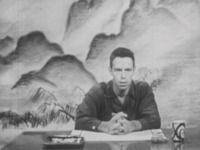
13 episodes, 1959, KQED (San Francisco)
From WNET:
"This series of programs deals with the themes of Eastern philosophy and their application to modern life. The programs are illustrated by Chinese and Japanese paintings and other Asian objects of art. Photographs and physical demonstrations of various principles and processes are also incorporated in the presentation. Host Alan Watts uses Chinese ink and rush for drawings and diagrams he executes during the series."
Looking at modern art
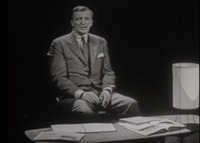
13 episodes, 1956, WQED (Pittsburgh)
From WNET:
"This series is designed for those who find modern art baffling. Gordon E. Washburn, director of the department of fine arts of Carnegie Institute in Pittsburgh, acts as the viewers’ guide in perusing more than 100 priceless examples of masterpieces of modern art. He discusses the leading artists of various modern art movements and examines their motives, their ideas, and their works to give the viewer an understanding, and it is hoped, an appreciation of this contemporary art."
Design workshop
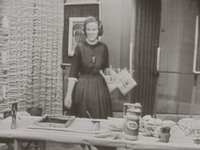
13 episodes, 1959, KQED (San Francisco)
From WNET:
"'Design Workshop' combines are appreciation with do-it-yourself tops for home art enthusiasts. Covering a variety of topics in fine arts and handicraft, the series offers an audience of all ages a chance to gain a greater appreciation of art and artistic goals. In teaching arts and crafts in “Design Workshop,” Miss Pearson utilizes artistic tools ranging from paper, crayons and pencils to the camera and the potter’s wheel. She deals with stick figures, cardboard marionettes, paintings, pottery, sculpture, and stained glass windows in discussing the elements of good design. Miss Pearson begins the 13-week series with a discussion of who is an artist and how long art has existed. Her subsequent programs range from the “sausage method” of stick figures to what makes a photograph with telecasts devoted to textures, colors, shapes, figures, and the use of space, line and form in design. At the end of each program, she suggests home practices for “Design Workshop” viewers. Miss Pearson’s pottery and ceramic sculpture has been exhibited in New York, Los Angeles, and San Francisco. She holds fine arts degrees from Syracuse University and the New York State College of Ceramics at Alfred University. Additionally she has studied with England’s leading potter, Bernard Leach, and she spent over a year in Italy doing research and study under an Italian Government Fellowship. “Design Workshop” was produced by KQED, San Francisco for the National Educational Television and Radio Center."
World of art
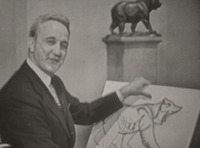
13 episodes, 1957, WQED (Pittsburgh)
From WNET:
"These programs are designed to give a brief historical background of the various art expressions and their influences upon contemporary art. In addition, many media and techniques will be used and demonstrated creatively with the purpose of stimulating interest in art on the part of the TV audience to have it actively take tools and materials in hand to do an original piece of work. The series, produced by WQED, Pittsburgh, will cover a wide variety of art types: sculpture, various materials, paint, clay, and metal will serve as an orientation program for the adult. The producer and director is Sam Silberman."
Visits with a sculptor
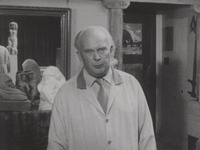
10 episodes, 1957, Department of Cinema, University of California
From WNET:
"This series -- a rerun -- centers around sculpture, one of the oldest of the arts. Through the media of wood, clay, and stone, sculptor Merrell Gage expresses with his hands the conceptions of his mind. As Gage works, he discusses the problems of the sculptor -- composition, form, dimension, proportion, and feeling. In particular he explains the techniques inherent in the different artistic media. But more than a mechanical process, sculpture is an expression of an artist's sensitivity to life in all its varied hues. Therefore, throughout the series, Gage not only attempts to create an understanding of sculpture but an understanding of the artist as well. VISITS WITH A SCULPTOR was produced by the Department of Cinema at the University of Southern California. Production Supervisor: David Johnson. Directors: Edward Freed and David Johnson. Director of Photography: Richard Harber."
The painting
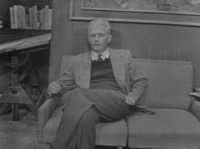
7 episodes, 1957, KETC (St. Louis)
From WNET:
"National Educational Television achieves another first in this series of programs which originated at KETC, St. Louis. It’s the first time that an artist has produced a painting before the glaring lights and grinding cameras of the television studio – and before a multitude of viewers. Working on a rigid, inflexible, split-second deadline, Siegfried Reinhardt paints a picture entitled “The Man of Sorrows,” a religious work whose central figure is Christ. Reinhardt brings the painting from bare concept to completion without benefit or “gimmicks.” The entire work was done before the cameras strictly on an “ad lib” basis. The series shows step-by-step the way a painting is produced. It is designed to bring viewers closer to all good paintings and artists by providing insight into the problems and hopes, frustrations and rewards, which the painter must undergo."
The intent of art

7 episodes, 1959, WGBH (Boston)
From WNET:
"This series explores some of the purposes which underlie works of art, with reference to their meaning for the average person in today’s world. Drawing principally on the collection of the Museum of Fine Arts in Boston, Bartlett H. Hayes Jr. discusses such topics as art as utility, social order and natural knowledge, and considers such questions as “Is it really true that modern art doesn’t communicate as clearly as art of the past?” The programs originated live from the galleries of the Museum of Fine Arts."

